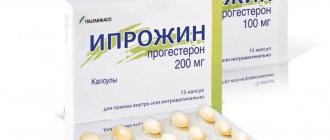Pharmacodynamics and pharmacokinetics
Insulin Actrapid is produced by recombinant DNA biotechnology using the Saccharomyces cerevisiae strain. Its INN is Insulin human.
The drug interacts with the receptor on the outer cytoplasmic membrane of cells. It forms an insulin-receptor complex . It activates intracellular processes by stimulating the biosynthesis of cAMP or by penetrating into the muscle cell.
The decrease in glucose levels is due to increased intracellular transport and uptake by tissues, activation of lipogenesis , protein synthesis and glycogenogenesis , as well as a decrease in the rate of glucose production by the liver, etc.
The effect of the product begins within 30 minutes after application. The maximum effect is noticeable on average within 2.5 hours. The total duration of action is 7-8 hours.
Individual characteristics for patients are possible, including those depending on the dosage size.
special instructions
If the dose is incorrectly selected or when the drug is discontinued, there is a risk of developing hyperglycemia, especially in patients with type 1 diabetes mellitus. The first symptoms of this complication usually appear gradually, over several hours or days: nausea, severe drowsiness, dry mouth, vomiting, dry and reddened skin, loss of appetite, thirst, smell of acetone from the mouth, increased urine output.
If hyperglycemia is left untreated in patients with type 1 diabetes, life-threatening diabetic ketoacidosis may develop. With a significant improvement in glycemic control (for example, due to intensified insulin therapy), the usual symptoms that are precursors of hypoglycemia may change, about which it is imperative to warn patients. It should be borne in mind that the precursors of hypoglycemia may become less pronounced in patients who are transferred from one type of insulin to another.
Patients who are planning to travel across time zones should consult with their doctor about the regimen for using Actrapid NM, since they will have to change the timing of meals and administration of the drug.
If there is a change in the type of insulin (human, animal or human analog), its type, biological activity, manufacturer and/or manufacturing method, it may be necessary to change the dosage regimen of the drug. For this reason, transferring patients to another type of insulin or insulin manufactured by another pharmacological company should be carried out under the close supervision of a physician.
If it is necessary to adjust the dose, this can be done both when administering the first dose and in the first weeks/months of therapy.
Insulin requirements usually increase in patients with underlying medical conditions, especially fever and infections.
Hypoglycemia may occur if you skip meals or engage in unplanned heavy physical activity.
Actrapid NM should not be used for continuous subcutaneous insulin infusions (CSII) in insulin pumps, since it is impossible to predict how much insulin will be absorbed by the infusion system.
Metacresol, which is part of the drug, can cause allergic reactions.
Insulin does not cross the placental barrier, so there are no restrictions on its use during pregnancy. Moreover, if a pregnant woman's diabetes is not treated, there is a danger to the fetus. Considering this, treatment of the disease during pregnancy should be continued. However, women, including those planning a pregnancy, should be under constant medical supervision with enhanced monitoring of blood glucose levels, since hyperglycemia and hypoglycemia, which can develop with an incorrectly selected dose of insulin, increase the risk of fetal malformations and intrauterine death. It should be taken into account that in the first trimester of pregnancy the need for insulin usually decreases, and in the second and third trimester it gradually increases. After childbirth, the need for insulin quickly returns to the level it was before pregnancy.
Similarly, there are no restrictions on the use of Actrapid NM during breastfeeding, since the drug does not pose a danger to the child. However, a woman may need to adjust her insulin dose and/or diet.
Hyperglycemia and hypoglycemia can impair the speed of reactions and the ability of a diabetic patient to concentrate, which is dangerous in cases where these reactions are necessary, for example, when driving a car or working with machinery. Patients should be advised to take measures to prevent the development of hyperglycemia/hypoglycemia. This is especially important for people who suffer from frequent episodes of hypoglycemia and who have no or mild symptoms that are warning signs of developing hypoglycemia. In these cases, the feasibility of performing potentially hazardous activities is assessed.
Instructions for use of Actrapid (Method and dosage)
The instructions for Actrapid indicate that the drug is administered subcutaneously or intravenously. The dosage is selected by a specialist individually depending on the patient's insulin . As a rule, the dosage is 0.3-1 IU/kg per day. With insulin resistance, the need may be higher, and in the case of residual endogenous insulin production may be lower. Patients should be carefully monitored for blood .
In case of kidney or liver dysfunction, the need for insulin is less. So you need to adjust the dosage.
Instructions for use of Actrapid indicate that it can be used in combination with long-acting insulins .
The medicine is administered half an hour before a meal or light snack with carbohydrates. As a rule, injections are made subcutaneously in the area of the anterior abdominal wall. This ensures accelerated absorption. In addition, injections can be given in the thigh, deltoid muscle of the shoulder or buttock. To prevent lipodystrophy, injection sites need to be changed.
Intravenous administration is only permissible if the injections are given by a medical professional. The medicine is administered intramuscularly only as prescribed by a specialist.
Side effects
The most common side effect of the drug is hypoglycemia, which develops in cases where the dose of insulin significantly exceeds the patient's need for it. Severe hypoglycemia may cause seizures and/or loss of consciousness, possibly impaired brain function, and even death.
Other possible adverse reactions:
- From the immune system: uncommon (> 1/1000, < 1/100) – rash, urticaria; very rarely (<1/10,000, including isolated spontaneous cases) - anaphylactic reactions, generalized hypersensitivity that poses a threat to the patient’s life (generalized skin rash, sweating, itching, angioedema, disorders of the gastrointestinal tract, decreased blood pressure, rapid heartbeat, fainting/loss of consciousness);
- From the nervous system: very rarely - peripheral neuropathy;
- On the part of the organ of vision: infrequently - refractive errors (usually occur at the beginning of treatment and are usually reversible); very rarely - diabetic retinopathy;
- From the subcutaneous tissues and skin: infrequently - lipodystrophy at the injection site (in cases where the drug is constantly injected into the same area);
- Local reactions at the injection site: swelling, redness of the skin, pain, itching, hematoma formation (these reactions are usually transient and disappear with continued therapy).
Overdose
In case of an overdose, the following are possible: insomnia , excessive pallor, increased agitation and appetite , tremor , sweating , headache , paresthesia in the mouth, palpitations. If the medicine is used in dosages that greatly exceed the norm, the patient may fall into a coma .
In case of mild hypoglycemia, you should eat sugar or sugar-rich foods. In case of severe overdose, 1 mg of Glucagon . If necessary, additional concentrated glucose solutions are administered.
Interaction
The hypoglycemic effect of insulin increases when taking oral hypoglycemic agents , angiotensin-converting enzyme inhibitors , non-selective beta-blockers , sulfonamides , tetracyclines , Ketoconazole , Pyridoxine , cyclophosphamide , lithium preparations, and carbonic anhydrase inhibitors , Bromocriptine , anabolic steroids , K lofibrate , mebendazole , theophylline , fenfluramine and medications containing ethanol. Alcohol not only enhances, but also prolongs the effect of Actrapid.
The hypoglycemic effect, on the contrary, is reduced under the influence of oral contraceptives , thyroid hormones , Heparin , sympathomimetics , Clonidine , Diazoxide , Phenytoin , glucocorticosteroids , thiazide diuretics , tricyclic antidepressants , Danazol , calcium channel blockers , morphine , nicotine .
The effect of Actrapid can be either enhanced or weakened due to the use of Reserpine and salicylates . Octreotide , Lanreotide may reduce or increase the need for insulin .
Taking beta blockers may mask the symptoms of hypoglycemia and prevent its resolution.
Some products, such as those containing thiols or sulfites , can cause insulin .
Actrapid price, where to buy
The price of Actrapid is about 450 rubles. You can buy this product only with a doctor's prescription.
The price of insulin Actrapid HM Penfill is approximately 950 rubles. Thus, the medicine is considered quite expensive. In some online pharmacies, the price of Actrapid may be higher than indicated.
- Online pharmacies in RussiaRussia
- Online pharmacies in UkraineUkraine
ZdravCity
- Actrapid NM penfill solution for injection.
100 IU/ml 3ml 5 pcs. Novo Nordisk 886 rub. order
Pharmacy Dialogue
- Actrapid NM (insulin) bottle 100IU/ml 10mlNovo Nordisk
RUB 371 order
- Actrapid NM Penfill cartridges 100IU/ml 3ml No. 5Novo Nordisk
RUB 859 order
show more
Pharmacy24
- Actrapid NM 100 U/ml 10ml solution for injection
340 UAH. order - Actrapid NM Penfil 100ME/ml N5 solution
681 UAH order
What does a prescription form look like?
The prescription for Actrapid is almost always written in Latin. To receive the medicine, the person will be given a form that says the following:
- Rp: Actrapid HM 100 ME/ml – 10 ml;
- DS subcutaneous administration at the dose prescribed by the doctor.
The first line contains information for the pharmacist: in what package and in what quantity to dispense the medication, and the bottom line indicates that the medicine must be administered subcutaneously in compliance with the dosage selected by the endocrinologist.









